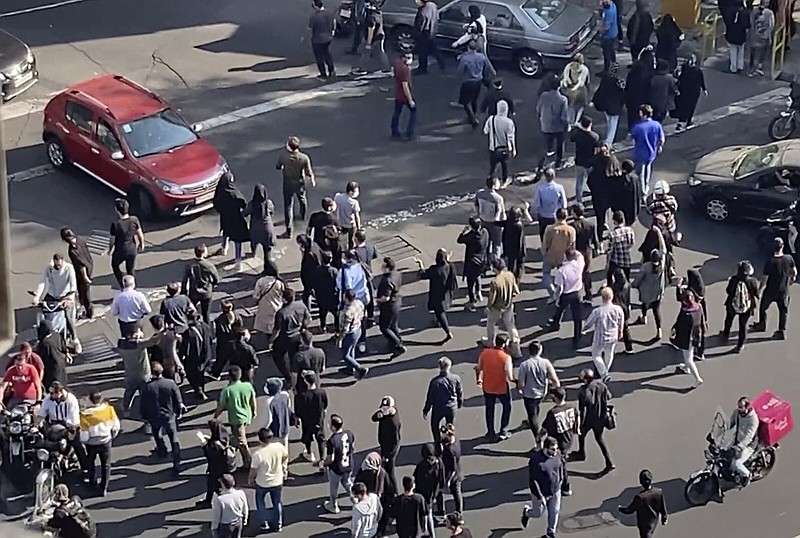DUBAI, United Arab Emirates -- Gunmen attacked a major Shiite holy site in Iran on Wednesday, killing at least 15 people and wounding dozens. The attack came as protesters elsewhere in Iran marked a symbolic 40 days since a woman's death in custody ignited the biggest anti-government movement in over a decade.
State TV blamed the attack on "takfiris," a term that refers to Sunni Muslim extremists who have targeted the country's Shiite majority in the past. The attack appeared to be unrelated to the demonstrations.
The official website of the judiciary said two gunmen were arrested and a third is on the run after the attack on the Shah Cheragh mosque, the second holiest site in Iran. The state-run IRNA news agency reported the death toll and state TV said 40 people were wounded.
An Iranian news website considered to be close to the Supreme National Security Council reported that the attackers were foreign nationals, without elaborating.
The Islamic State group late Wednesday claimed responsibility for the attack on its Amaq news agency. It said an armed IS militant stormed the shrine and opened fire on its visitors. It claimed that some 20 people were killed and dozens more were wounded.
Such attacks are rare in Iran, but this past April an assailant stabbed two clerics to death at the Imam Reza shrine, the country's most revered Shiite site, in the northeast city of Mashhad.
Iranian President Ebrahim Raisi said that whoever led and planned the attack will "receive a regretful and decisive response," without elaborating. IRNA quoted Raisi as saying, "This evil will definitely not go unanswered."
Earlier on Wednesday, thousands of protesters had poured into the streets of a northwestern city to mark the watershed 40 days since the death in custody of 22-year-old Mahsa Amini, whose tragedy sparked the protests.
Deaths are commemorated in Shiite Islam -- as in many other traditions -- again 40 days later, typically with an outpouring of grief. In Amini's Kurdish hometown of Saqez, the birthplace of the nationwide unrest now roiling Iran, crowds snaked through the local cemetery and thronged her grave.
"Death to the dictator!" protesters cried, according to video footage that corresponds with known features of the city and Aichi Cemetery. Women ripped off their headscarves, or hijabs, and waved them above their heads. Other videos showed a massive procession making its way along a highway and through a dusty field toward Amini's grave. There were reports of road closures in the area.
State-linked media reported 10,000 protesters in the procession to her grave.
Hengaw, a Kurdish human rights group, said security forces fired tear gas to disperse demonstrators. The semiofficial ISNA news agency said security forces fired pellets at crowds of demonstrators on the outskirts of Saqez and pushed back demonstrators who tried to attack the governor's office. It said local internet access was cut off due to "security considerations."
Earlier in the day, Kurdistan Gov. Esmail Zarei Koosha insisted that traffic was flowing as normal, calling the situation "completely stable."
State-run media announced that schools and universities in Iran's northwestern region would close, purportedly to curb "the spread of influenza."
In downtown Tehran, the capital, major sections of the traditional grand bazaar closed in solidarity with the protests. Crowds clapped and shouted "Freedom! Freedom! Freedom!" through the labyrinthine marketplace.
"This year is a year of blood!" they also chanted. "[Supreme Leader Ayatollah Ali Khamenei] will be toppled!"
Amini, detained for allegedly violating the country's strict dress code for women, remains the potent symbol of protests that have posed one of the most serious challenges to the Islamic Republic.
With the slogan #WomanLifeFreedom, the demonstrations first focused on women's rights and the state-mandated hijab, or headscarf for women. But they quickly evolved into calls to oust the Shiite clerics who have ruled Iran since the 1979 Islamic Revolution.
Since the protests erupted, security forces have fired live ammunition and tear gas to disperse demonstrations, killing over 200 people, according to rights groups.
Untold numbers have been arrested, with estimates in the thousands. Iranian judicial officials announced this week they would bring more than 600 people to trial over their role in the protests, including 315 in Tehran, 201 in the neighboring Alborz province and 105 in the southwestern province of Khuzestan.

